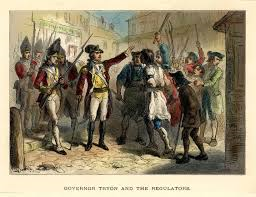Regulator Movement in North Carolina
Regulator Movement in North Carolina
The Regulator Movement was a significant uprising in the North Carolina colony, primarily during the late 1760s and early 1770s. This movement was a reaction against the perceived abuses of power by colonial officials and the local aristocracy, particularly in issues related to taxation and the administration of justice. The Regulators, as the participants were known, sought to reform the government and ensure a more equitable system of representation and taxation.
Background[edit | edit source]
The roots of the Regulator Movement can be traced back to the rapid population growth in North Carolina's backcountry regions during the mid-18th century. This expansion led to increased demands for land, representation, and local government services, which were not adequately met by the colonial authorities. The settlers in these areas, many of whom were small farmers, felt marginalized by the political and economic power structures dominated by the coastal elites.
Compounding these grievances were corrupt practices among local officials, including sheriffs and court officers, who often exploited their positions for personal gain. High taxes, coupled with a lack of transparency and accountability in their collection and expenditure, further fueled discontent among the backcountry settlers.
The Movement[edit | edit source]
The Regulator Movement formally began around 1766 when aggrieved residents of the backcountry organized to demand reforms. The movement's name derives from its members' desire to "regulate" the government's abuses and restore a sense of fairness and justice to the colony's administration.
The Regulators initially sought peaceful means to address their grievances, petitioning the colonial assembly and Governor William Tryon for redress. However, their demands were largely ignored, leading to increased frustration and radicalization among the movement's supporters.
Climax and Suppression[edit | edit source]
The situation escalated to violence in May 1771, culminating in the Battle of Alamance, where Governor Tryon's militia confronted a group of Regulators. The battle, which took place in present-day Alamance County, resulted in a decisive defeat for the Regulators. This defeat, coupled with subsequent punitive measures against the movement's leaders, effectively ended the Regulator Movement as an organized resistance.
Legacy[edit | edit source]
While the Regulator Movement was ultimately unsuccessful in achieving its immediate goals, it had a lasting impact on North Carolina and the broader American Revolution. The movement highlighted the deep-seated grievances and divisions between the colony's eastern and western regions, foreshadowing the debates over representation and taxation that would fuel the American Revolution.
Moreover, the Regulator Movement is seen by many historians as a precursor to the revolutionary sentiments that swept through the American colonies in the 1770s. It underscored the growing dissatisfaction with British colonial rule and the desire among the American colonists for a government that was more responsive and accountable to its citizens.
See Also[edit | edit source]
![]()
This American history related article is a stub. You can help WikiMD by expanding it.
Search WikiMD
Ad.Tired of being Overweight? Try W8MD's physician weight loss program.
Semaglutide (Ozempic / Wegovy and Tirzepatide (Mounjaro / Zepbound) available.
Advertise on WikiMD
|
WikiMD's Wellness Encyclopedia |
| Let Food Be Thy Medicine Medicine Thy Food - Hippocrates |
Translate this page: - East Asian
中文,
日本,
한국어,
South Asian
हिन्दी,
தமிழ்,
తెలుగు,
Urdu,
ಕನ್ನಡ,
Southeast Asian
Indonesian,
Vietnamese,
Thai,
မြန်မာဘာသာ,
বাংলা
European
español,
Deutsch,
français,
Greek,
português do Brasil,
polski,
română,
русский,
Nederlands,
norsk,
svenska,
suomi,
Italian
Middle Eastern & African
عربى,
Turkish,
Persian,
Hebrew,
Afrikaans,
isiZulu,
Kiswahili,
Other
Bulgarian,
Hungarian,
Czech,
Swedish,
മലയാളം,
मराठी,
ਪੰਜਾਬੀ,
ગુજરાતી,
Portuguese,
Ukrainian
Medical Disclaimer: WikiMD is not a substitute for professional medical advice. The information on WikiMD is provided as an information resource only, may be incorrect, outdated or misleading, and is not to be used or relied on for any diagnostic or treatment purposes. Please consult your health care provider before making any healthcare decisions or for guidance about a specific medical condition. WikiMD expressly disclaims responsibility, and shall have no liability, for any damages, loss, injury, or liability whatsoever suffered as a result of your reliance on the information contained in this site. By visiting this site you agree to the foregoing terms and conditions, which may from time to time be changed or supplemented by WikiMD. If you do not agree to the foregoing terms and conditions, you should not enter or use this site. See full disclaimer.
Credits:Most images are courtesy of Wikimedia commons, and templates Wikipedia, licensed under CC BY SA or similar.
Contributors: Prab R. Tumpati, MD

